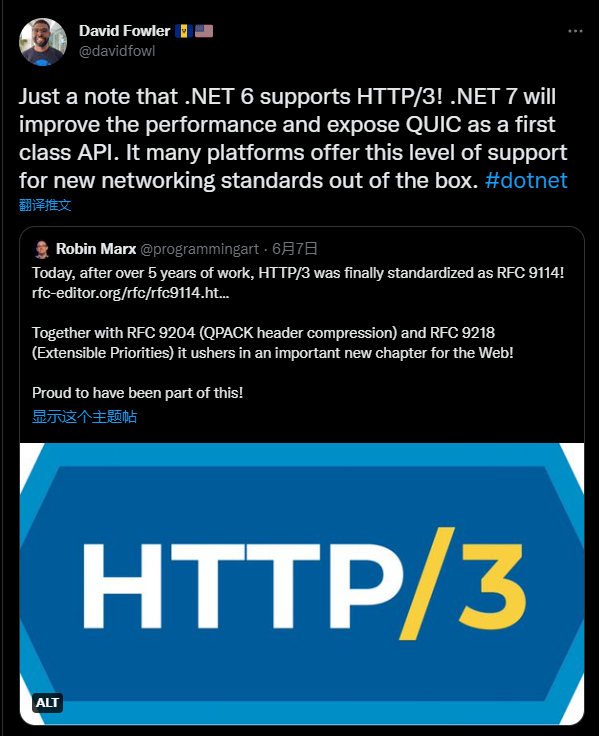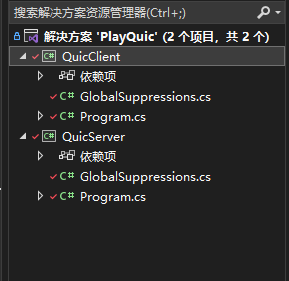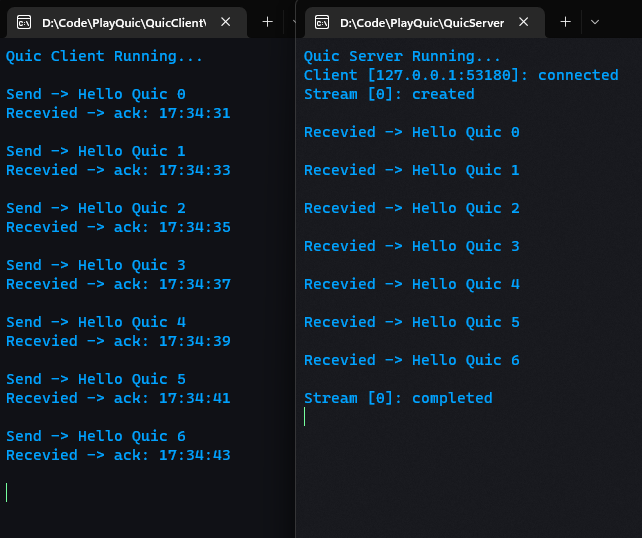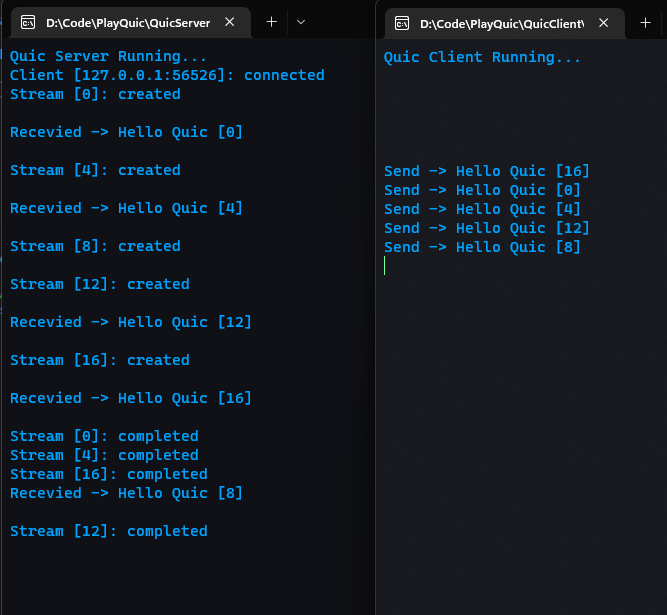前言
随着今年6月份的 HTTP/3 协议的正式发布,它背后的网络传输协议 QUIC,凭借其高效的传输效率和多路并发的能力,也大概率会取代我们熟悉的使用了几十年的 TCP,成为互联网的下一代标准传输协议。
在去年 .NET 6 发布的时候,已经可以看到 HTTP/3 和 Quic 支持的相关内容了,但是当时 HTTP/3 的 RFC 还没有定稿,所以也只是预览功能,而 Quic 的 API 也没有在 .NET 6 中公开。
在最新的 .NET 7 中,.NET 团队公开了 Quic API,它是基于 MSQuic 库来实现的 , 提供了开箱即用的支持,命名空间为 System.Net.Quic。

Quic API
下面的内容中,我会介绍如何在 .NET 中使用 Quic。
下面是 System.Net.Quic 命名空间下,比较重要的几个类。
QuicConnection
表示一个 QUIC 连接,本身不发送也不接收数据,它可以打开或者接收多个QUIC 流。
QuicListener
用来监听入站的 Quic 连接,一个 QuicListener 可以接收多个 Quic 连接。
QuicStream
表示 Quic 流,它可以是单向的 (QuicStreamType.Unidirectional),只允许创建方写入数据,也可以是双向的(QuicStreamType.Bidirectional),它允许两边都可以写入数据。
小试牛刀
下面是一个客户端和服务端应用使用 Quic 通信的示例。
- 分别创建了 QuicClient 和 QuicServer 两个控制台程序。

项目的版本为 .NET 7, 并且设置 EnablePreviewFeatures = true。
下面创建了一个 QuicListener,监听了本地端口 9999,指定了 ALPN 协议版本。
Console.WriteLine("Quic Server Running...");
// 创建 QuicListener
var listener = await QuicListener.ListenAsync(new QuicListenerOptions
{
ApplicationProtocols = new List<SslApplicationProtocol> { SslApplicationProtocol.Http3 },
ListenEndPoint = new IPEndPoint(IPAddress.Loopback,9999),
ConnectionOptionsCallback = (connection,ssl, token) => ValueTask.FromResult(new QuicServerConnectionOptions()
{
DefaultStreamErrorCode = 0,
DefaultCloseErrorCode = 0,
ServerAuthenticationOptions = new SslServerAuthenticationOptions()
{
ApplicationProtocols = new List<SslApplicationProtocol>() { SslApplicationProtocol.Http3 },
ServerCertificate = GenerateManualCertificate()
}
})
});
因为 Quic 需要 TLS 加密,所以要指定一个证书,GenerateManualCertificate 方法可以方便地创建一个本地的测试证书。
X509Certificate2 GenerateManualCertificate()
{
X509Certificate2 cert = null;
var store = new X509Store("KestrelWebTransportCertificates", StoreLocation.CurrentUser);
store.Open(OpenFlags.ReadWrite);
if (store.Certificates.Count > 0)
{
cert = store.Certificates[^1];
// rotate key after it expires
if (DateTime.Parse(cert.GetExpirationDateString(), null) < DateTimeOffset.UtcNow)
{
cert = null;
}
}
if (cert == null)
{
// generate a new cert
var now = DateTimeOffset.UtcNow;
SubjectAlternativeNameBuilder sanBuilder = new();
sanBuilder.AddDnsName("localhost");
using var ec = ECDsa.Create(ECCurve.NamedCurves.nistP256);
CertificateRequest req = new("CN=localhost", ec, HashAlgorithmName.SHA256);
// Adds purpose
req.CertificateExtensions.Add(new X509EnhancedKeyUsageExtension(new OidCollection
{
new("1.3.6.1.5.5.7.3.1") // serverAuth
}, false));
// Adds usage
req.CertificateExtensions.Add(new X509KeyUsageExtension(X509KeyUsageFlags.DigitalSignature, false));
// Adds subject alternate names
req.CertificateExtensions.Add(sanBuilder.Build());
// Sign
using var crt = req.CreateSelfSigned(now, now.AddDays(14)); // 14 days is the max duration of a certificate for this
cert = new(crt.Export(X509ContentType.Pfx));
// Save
store.Add(cert);
}
store.Close();
var hash = SHA256.HashData(cert.RawData);
var certStr = Convert.ToBase64String(hash);
//Console.WriteLine($"\n\n\n\n\nCertificate: {certStr}\n\n\n\n"); // <-- you will need to put this output into the JS API call to allow the connection
return cert;
}
阻塞线程,直到接收到一个 Quic 连接,一个 QuicListener 可以接收多个 连接。
var connection = await listener.AcceptConnectionAsync();
Console.WriteLine($"Client [{connection.RemoteEndPoint}]: connected");
接收一个入站的 Quic 流, 一个 QuicConnection 可以支持多个流。
var stream = await connection.AcceptInboundStreamAsync();
Console.WriteLine($"Stream [{stream.Id}]: created");
接下来,使用 System.IO.Pipeline 处理流数据,读取行数据,并回复一个 ack 消息。
Console.WriteLine();
await ProcessLinesAsync(stream);
Console.ReadKey();
// 处理流数据
async Task ProcessLinesAsync(QuicStream stream)
{
var reader = PipeReader.Create(stream);
var writer = PipeWriter.Create(stream);
while (true)
{
ReadResult result = await reader.ReadAsync();
ReadOnlySequence<byte> buffer = result.Buffer;
while (TryReadLine(ref buffer, out ReadOnlySequence<byte> line))
{
// 读取行数据
ProcessLine(line);
// 写入 ACK 消息
await writer.WriteAsync(Encoding.UTF8.GetBytes($"Ack: {DateTime.Now.ToString("HH:mm:ss")} \n"));
}
reader.AdvanceTo(buffer.Start, buffer.End);
if (result.IsCompleted)
{
break;
}
}
Console.WriteLine($"Stream [{stream.Id}]: completed");
await reader.CompleteAsync();
await writer.CompleteAsync();
}
bool TryReadLine(ref ReadOnlySequence<byte> buffer, out ReadOnlySequence<byte> line)
{
SequencePosition? position = buffer.PositionOf((byte)'\n');
if (position == null)
{
line = default;
return false;
}
line = buffer.Slice(0, position.Value);
buffer = buffer.Slice(buffer.GetPosition(1, position.Value));
return true;
}
void ProcessLine(in ReadOnlySequence<byte> buffer)
{
foreach (var segment in buffer)
{
Console.WriteLine("Recevied -> " + System.Text.Encoding.UTF8.GetString(segment.Span));
}
Console.WriteLine();
}
以上就是服务端的完整代码了。
接下来我们看一下客户端 QuicClient 的代码。
直接使用 QuicConnection.ConnectAsync 连接到服务端。
Console.WriteLine("Quic Client Running...");
await Task.Delay(3000);
// 连接到服务端
var connection = await QuicConnection.ConnectAsync(new QuicClientConnectionOptions
{
DefaultCloseErrorCode = 0,
DefaultStreamErrorCode = 0,
RemoteEndPoint = new IPEndPoint(IPAddress.Loopback, 9999),
ClientAuthenticationOptions = new SslClientAuthenticationOptions
{
ApplicationProtocols = new List<SslApplicationProtocol> { SslApplicationProtocol.Http3 },
RemoteCertificateValidationCallback = (sender, certificate, chain, errors) =>
{
return true;
}
}
});
创建一个出站的双向流。
// 打开一个出站的双向流
var stream = await connection.OpenOutboundStreamAsync(QuicStreamType.Bidirectional);
var reader = PipeReader.Create(stream);
var writer = PipeWriter.Create(stream);
后台读取流数据,然后循环写入数据。
// 后台读取流数据
_ = ProcessLinesAsync(stream);
Console.WriteLine();
// 写入数据
for (int i = 0; i < 7; i++)
{
await Task.Delay(2000);
var message = $"Hello Quic {i} \n";
Console.Write("Send -> " + message);
await writer.WriteAsync(Encoding.UTF8.GetBytes(message));
}
await writer.CompleteAsync();
Console.ReadKey();
ProcessLinesAsync 和服务端一样,使用 System.IO.Pipeline 读取流数据。
async Task ProcessLinesAsync(QuicStream stream)
{
while (true)
{
ReadResult result = await reader.ReadAsync();
ReadOnlySequence<byte> buffer = result.Buffer;
while (TryReadLine(ref buffer, out ReadOnlySequence<byte> line))
{
// 处理行数据
ProcessLine(line);
}
reader.AdvanceTo(buffer.Start, buffer.End);
if (result.IsCompleted)
{
break;
}
}
await reader.CompleteAsync();
await writer.CompleteAsync();
}
bool TryReadLine(ref ReadOnlySequence<byte> buffer, out ReadOnlySequence<byte> line)
{
SequencePosition? position = buffer.PositionOf((byte)'\n');
if (position == null)
{
line = default;
return false;
}
line = buffer.Slice(0, position.Value);
buffer = buffer.Slice(buffer.GetPosition(1, position.Value));
return true;
}
void ProcessLine(in ReadOnlySequence<byte> buffer)
{
foreach (var segment in buffer)
{
Console.Write("Recevied -> " + System.Text.Encoding.UTF8.GetString(segment.Span));
Console.WriteLine();
}
Console.WriteLine();
}
到这里,客户端和服务端的代码都完成了,客户端使用 Quic 流发送了一些消息给服务端,服务端收到消息后在控制台输出,并回复一个 Ack 消息,因为我们创建了一个双向流。
程序的运行结果如下

我们上面说到了一个 QuicConnection 可以创建多个流,并行传输数据。
改造一下服务端的代码,支持接收多个 Quic 流。
var cts = new CancellationTokenSource();
while (!cts.IsCancellationRequested)
{
var stream = await connection.AcceptInboundStreamAsync();
Console.WriteLine($"Stream [{stream.Id}]: created");
Console.WriteLine();
_ = ProcessLinesAsync(stream);
}
Console.ReadKey();
对于客户端,我们用多个线程创建多个 Quic 流,并同时发送消息。
默认情况下,一个 Quic 连接的流的限制是 100,当然你可以设置 QuicConnectionOptions 的 MaxInboundBidirectionalStreams 和 MaxInboundUnidirectionalStreams 参数。
for (int j = 0; j < 5; j++)
{
_ = Task.Run(async () => {
// 创建一个出站的双向流
var stream = await connection.OpenOutboundStreamAsync(QuicStreamType.Bidirectional);
var writer = PipeWriter.Create(stream);
Console.WriteLine();
await Task.Delay(2000);
var message = $"Hello Quic [{stream.Id}] \n";
Console.Write("Send -> " + message);
await writer.WriteAsync(Encoding.UTF8.GetBytes(message));
await writer.CompleteAsync();
});
}
最终程序的输出如下

完整的代码可以在下面的 github 地址找到,希望对您有用!
https://github.com/SpringLeee/PlayQuic
扫码关注【半栈程序员】,获取最新文章。
 标签:Console,Quic,buffer,await,Echo,QUIC,var,new,NET
From: https://www.cnblogs.com/myshowtime/p/16864793.html
标签:Console,Quic,buffer,await,Echo,QUIC,var,new,NET
From: https://www.cnblogs.com/myshowtime/p/16864793.html